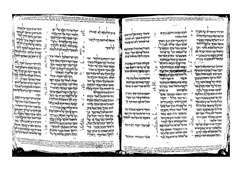Jeremiah 29
| Jeremiah 29 | |
|---|---|
 Book of Jeremiah in Hebrew Bible, MS. Sassoon 1053, images 283-315. | |
| Book | Book of Jeremiah |
| Bible part | Old Testament |
| Order in the Bible part | 24 |
| Category | Nevi'im |
Jeremiah 29 is the twenty-ninth chapter of the Book of Jeremiah in the Hebrew Bible or the Old Testament of the Christian Bible. It is numbered as Jeremiah 36 in Septuagint. This book compiles the prophecies spoken by the prophet Jeremiah, and is a part of the Books of the Prophets.[1][2]
Text
- The original text is written in Hebrew language.
- This chapter is divided into 32 verses.
Textual versions
Some most ancient manuscripts containing this chapter in Hebrew language:
- Masoretic Text (10th century)
Ancient translations in Koine Greek:
- Septuagint (3rd century BC; different verse numbering)
- Theodotion version (~AD 180)
Verse numbering
The order of chapters and verses of the Book of Jeremiah in the English Bibles, Masoretic Text (Hebrew), and Vulgate (Latin), in some places differs from that in Septuagint (LXX, the Greek Bible used in the Eastern Orthodox Church and others) according to Rahlfs or Brenton. The following table is taken with minor adjustments from Brenton's Septuagint, page 971.[3]
The order of CATSS based on Alfred Rahlfs' Septuaginta (1935), differs in some details from Joseph Ziegler's critical edition (1957) in Göttingen LXX. Swete's Introduction mostly agrees with Rahlfs edition (=CATSS).[3]
| Hebrew, Vulgate, English | Rahlfs'LXX (CATSS) | Brenton's LXX |
|---|---|---|
| 29:1-15,21-32 | 36:1-15,21-32 | |
| 29:16-20 | none | |
| 47:1-7 | 29:1-7 | |
| 49:7-22 | none | 29:7b-22 |
Verse 1
- Now these are the words of the letter that Jeremiah the prophet sent from Jerusalem to the remainder of the elders who were carried away captive—to the priests, the prophets, and all the people whom Nebuchadnezzar had carried away captive from Jerusalem to Babylon. (NKJV)[4]
- It may also imply that some of the "elders" there were executed in the revolt of 594 BC alluded in Jeremiah 29:21-23.[5]
Verse 2
- (This happened after Jeconiah the king, the queen mother, the eunuchs, the princes of Judah and Jerusalem, the craftsmen, and the smiths had departed from Jerusalem.) (NKJV)[6]
- The passage in parentheses provides the background from 2 Kings 24:8-16 about the deportation of king Jeconiah and many prominent leaders and skilled persons in 597 BC from Judah to Babylon, which is a method learned from the Assyrians to reduce the possibility of rebellion.[5] The letters were sent to counter the false prophecies or baseless assurance of speedy return from exile (Jeremiah 27).[7]
Verse 3
- The letter was sent by the hand of Elasah the son of Shaphan, and Gemariah the son of Hilkiah, whom Zedekiah king of Judah sent to Babylon, to Nebuchadnezzar king of Babylon, saying, (NKJV)[8]
- "Elasah the son of Shaphan" is likely a brother of Ahikam who is symphatetic to Jeremiah (Jeremiah 26:24).[5][7]
- "Gemariah the son of Hilkiah" may not be the same person as "Gemariah the son of Saphan", a member of Jehoiakim's administration (Jeremiah 36:10).[5]
Verse 10
- For thus says the Lord: After seventy years are completed at Babylon, I will visit you and perform My good word toward you, and cause you to return to this place. (NKJV)[9]
- "Seventy years": reiterated from Jeremiah 25:12, as also cited with great expectation in Daniel 9:2, and as a reminder to post-exile people of its fulfillment in Zechariah 1:12; Zechariah 7:5.[5]
Verse 11
- For I know the thoughts that I think toward you, says the Lord, thoughts of peace and not of evil, to give you a future and a hope. (NKJV)[10]
- "I know the thoughts that I think": God's unchangeable plan is to bring "peace" not "evil" to His people.[5]
See also
|
|
- Related Bible parts: 2 Chronicles 36, Ezra 1, Jeremiah 25, Daniel 1, Daniel 9, Daniel 10, Zechariah 1, Zechariah 7.
Notes and references
- ↑ J. D. Davis. 1960. A Dictionary of the Bible. Grand Rapids, Michigan: Baker Book House.
- ↑ Theodore Hiebert, et al. 1996. The New Interpreter's Bible: Volume VI. Nashville: Abingdon.
- 1 2 (CCEL - Brenton Jeremiah Appendix)
- ↑ Jeremiah 29:1
- 1 2 3 4 5 6 The Nelson Study Bible 1997, p. 1275-1277.
- ↑ Jeremiah 29:2
- 1 2 The New Oxford Annotated Bible with the Apocrypha, Augmented Third Edition, New Revised Standard Version, Indexed. Michael D. Coogan, Marc Brettler, Carol A. Newsom, Editors. Publisher: Oxford University Press, USA; 2007. pp. 1123-1125 Hebrew Bible. ISBN 978-0195288810
- ↑ Jeremiah 29:3
- ↑ Jeremiah 29:10
- ↑ Jeremiah 29:11
Bibliography
- The Nelson Study Bible. Thomas Nelson, Inc. 1997. ISBN 9780840715999.